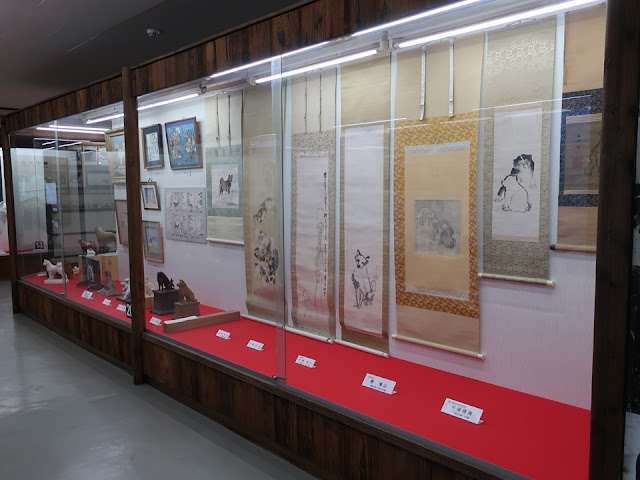It is said that the ancestor of Akita was a hound dog in a mountainous area. It is a partner of a hunter: Akita detects the place of a prey, it prevents a prey from leaving and it distracts a prey's attention when the hunter gets into danger. On the other hand, a hunter helps a dog if it gets into danger. Akita is a real partner.
The exhibition room is in the building of the Akita dog preservation society in Ohdate, Akita prefecture. The area of the room is same as that of two classrooms.
秋田犬の祖先は山岳猟犬の“秋田マタギ犬”だと言われています。猟師・マタギ(又鬼の字を当てる地方もあるそうです)の相棒で、獲物の場所を特定したり、獲物を足止めしたりするだけでなく、マタギが危険になった場合は、獲物の注意をそらすといいます。逆に、犬が危険な場合は、マタギが犬を守るというのでまさにパートナーです。大館市の秋田犬(いぬ)保存会の建物の中にある教室二つ分ぐらいの大きさの展示室です。
The photo above was taken in 1972. The hunter and the dog got the bear. Akita is dignified.
マタギと秋田犬、そして射止めた熊です(1972年)。凜々しい。
The full-scale model of a hunter’s room is exhibited.
The Japanese traditional hunters in this
region are called “Matagi”. They have their own rule, appreciate
blessings of nature and the mountain god, and live in a mountainous area. They
usually farm, but they stay at a shed in a mountain from the late autumn to the
early spring and shoot big animals such as a bear or an antelope. Akita always
lives with Matagi.
In winter, Matagi and Akita share their
fate; Akita is a partner, not a pet. However, a hunter who deserves “Matagi” is
rare now.
マタギの部屋の実物大模型。
マタギは、厳しい決まり事を持ち、自然の恵みや山の神に感謝し、山とともに暮らしていたそうです。普段は農作などで生計を立てていますが、晩秋から早春にかけて狩り小屋に泊まりながら熊やカモシカなどの大型獣を捕獲しています。秋田犬は普段からマタギとともに生活しています。
冬になると、マタギと秋田犬は、生死を共にするパートナー、ペットではなく、まさに相棒ですね。私にとっては、戸川幸夫の小説が全てです。でも、もう、マタギといえる人は少なくなったそうです。
Old outfit and a gun of “Matagi”. They chase animals in a snowy mountain.
毛皮を着て、藁の頭巾とブーツをまとい、雪山で獣を追う。ロマンを感じます。地図は、秋田県内にあったマタギ部落です。
Akita sits in front of hunted monkeys. He is dignified.
獲物(猿)を前にした秋田犬。いい顔ですね。
The other aspects of Akita、猟犬ではない秋田犬
Akita is originally a hound dog, then it is also raised as a watchdog. A big dog was used as a fighting dog. The dogfights were very popular, but it was prohibited around 1900.
In 1931, nine Akita dogs, which have original characteristics, were designated as national natural treasures. An exhibition has been held since then.
狩猟犬であった秋田犬は番犬としても飼育されるようになりました。そして、大きく育った犬たちは、闘犬として使われるようになりました。隆盛を極めましたが、明治末期には県下に闘犬廃止令が発令されました。昭和6年に、外来犬の特徴を排除して、秋田マタギ犬の特徴を持つ9頭の秋田犬が天然記念物に指定されてからは、展覧会が催されるようになりました。コンテストですね。
Commended dogs. 名誉章犬達。没した犬の毛皮も展示されています。ちょっと複雑な思いです。
These Akita had legends. Hachi-kou (on the left) waited for his master for ten years at Shibuya, Tokyo. His statue was built at the place where he was. Shiro brought the hunter’s license to his master who was arrested due to hunting without it. Shiro is enshrined as a deity of the Old-dog Shrine. Akita are loyal and smart.
渋谷で十年間、主人を待ち続けたハチ公。不法狩猟として捕らわれた主人にマタギ免状を届けようとしたシロ。シロは老犬神社の祭神になっています。秋田犬は義理堅く利口です。
Hanging scrolls and sculptures are exhibited. Akita dogs are familiar.
犬の掛け軸も多数。犬は身近なのですね。
Zagitova, who is a Russian figure skater, was fascinated by the photo of Akita. So, the preservation society presented her a dog. Nowadays, Akita dogs are popular all over the world. I wonder if they still have a characteristic to attack a bear or not.
秋田犬に魅せられたスケートのザギトワ選手に保存会から送られたMASARU(勝)です。海外でもAKITAで通じるほど有名になりました。熊を攻撃できるどう猛な性格が残っているのかどうか。
Akita is in the office of the society and outside of the building (upper right).
保存会の事務所に一歳の秋田犬がいました。また、保存会の建物の前に、秋田犬がいます(右上)が、眠そうでした。そりゃそうですねよ。
The museum shop would captivate a dog person.
ミュージアムショップは、わんちゃん好きにはたまらない品揃え。
The museum is at the second floor of the Akita dog preservation society building.
秋田犬会館。博物室は二階です。
Local Specialty of Ohdate、大館の比内地鶏
I had a lunch at Akita Hinai -ya which serves Hinai Chicken. It was “Hitsumabushi” of Hinai local chicken. There are four steps to enjoy it. 1. Scooping grilled chicken and rice to the rice bowl, and eat. 2. Adding condiments on it and eat. 3. Adding egg yolk into it and eat. 4. Pouring hot chicken soup into the bowl and eat. It was delicious.
I have eaten “Yeel Hitsumabushi” and “Seafood Hitsumabusi” which have a similar procedure to eat. The original one is “Yeel Hitsumabushi” in Nagoya, Aichi.
ランチは、大館の秋田比内やさんで比内地鶏ひつまぶしを頂きました。ご飯の上に焼いた鳥肉が載っています。そのままで食べ、薬味を付けて食べ、卵黄をかけて食べ、最後は土瓶で温めた鳥スープをかけて食べます。美味しかった。
金沢の海鮮ひつまぶし、名古屋のひつまぶしと合わせて、三冠です。
The photo above is a standard menu which is a bowl of rice with chicken, egg, and vegetables. It is called “Oya-Ko-Don”; “Oya” means a parent (chicken), “Ko” means a child (egg) and “Don” means a rice bowl. こちらは定番の親子丼。
Visited in October, 2020
Official website: http://akitainu.sakura.ne.jp/?lang=en
http://akitainu.sakura.ne.jp/?page_id=258
(in Japanese), accessed in June, 2021
Previous post (the largest museum in Akita):
Akita Prefectural Museum (2/2)、秋田県立博物館(2/2)
Next post (Museum
at the port town in Akita):
Tsuchizaki Minato Port Area Historical
Museum、秋田市土崎みなと歴史伝承館

















Comments
Post a Comment